Some of the best flowers to plant in Missouri bloom with immense vibrancy and fragrance. Gardeners and landscapers can paint a canvas of color, scent, and vitality with the bountiful array of flowers that thrive in Missouri’s climate. Our list showcases a selection of flowers meticulously chosen that thrive in this unique state. From the sunlit embrace of St. John’s Wort to the enchanting hues of Virginia Bluebells, each flower’s story weaves into the intricate fabric of the state’s diverse climate. As we delve into this kaleidoscope of blooms, we will discover the artistry of nature. But before we get to the list, let’s quickly go over how the USDA Plant Hardiness Zones affect flowers in Missouri.
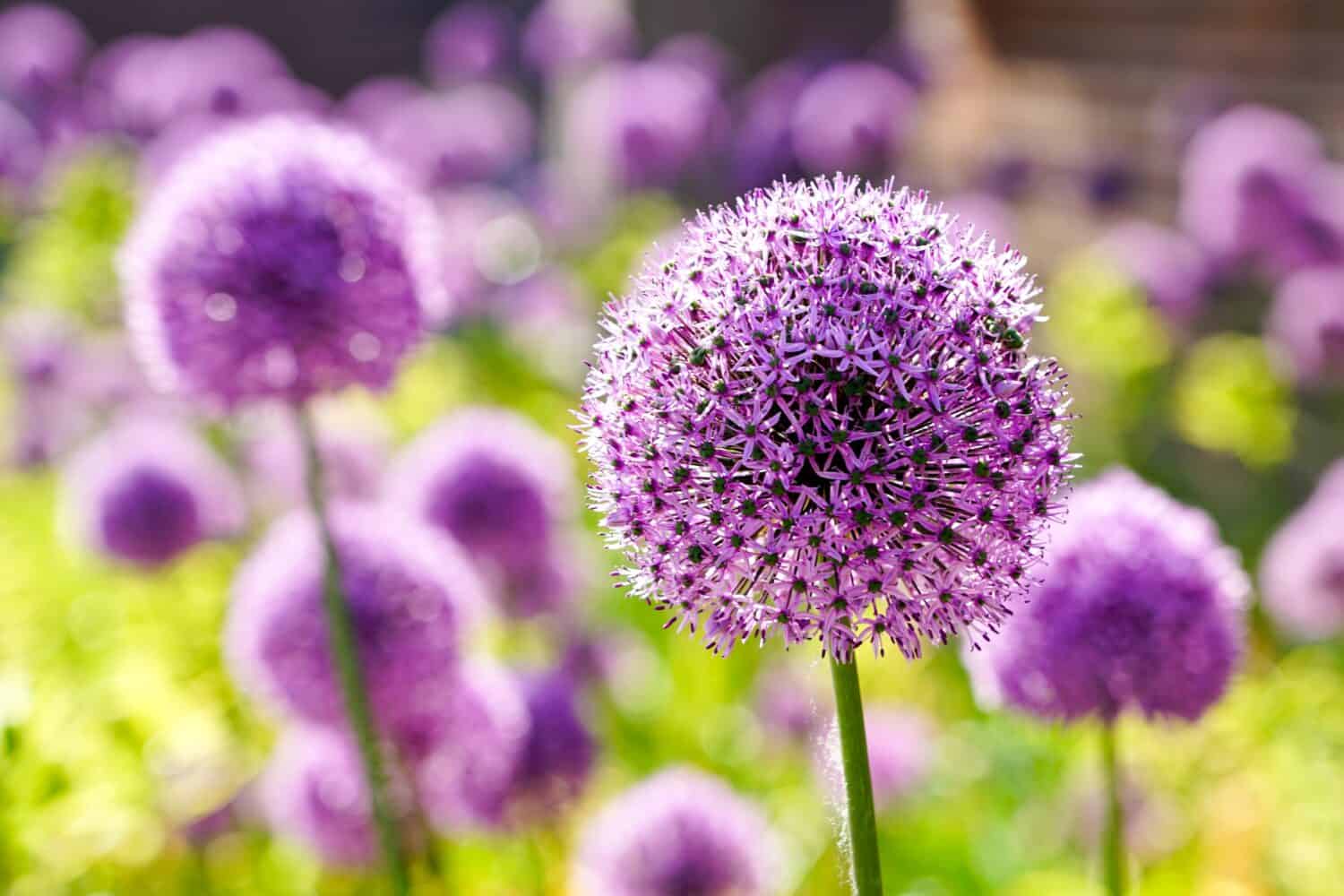
Missouri’s climate consists of five out of the eleven USDA Plant Hardiness Zones.
©Zigmunds Dizgalvis/Shutterstock.com
Missouri Plant Hardiness Zones
In the central United States, Missouri hosts a rich tapestry of plant life, including many species of flowers. Amidst this diversity, the USDA Plant Hardiness Zones serve as a vital compass for gardeners, landscapers, and plant enthusiasts. It consists of 11 separate planting zones, each representing a geographic region that experiences a specific average annual minimum temperature. This is a factor that is incredibly relevant to the survival of plants. Missouri is home to five of these zones. They include 5b in northern Missouri, 6a and 6b in central Missouri, as well as 7a and 7b in southern Missouri. Each of these zones delineates which plants can survive and thrive in the face of nature’s temperament.
Picture these zones as nature’s zip codes, each representing a specific climatic profile. But what do they mean, and how do they influence the world of flowers, plants, gardening, and landscaping?
Decoding the Zones
The USDA Plant Hardiness Zones reflect the average annual extreme minimum temperatures a region experiences. A lower zone number indicates colder winters, while higher numbers signify milder temperatures. Zones are divided into half-zones for more precision, offering a nuanced understanding of a locale’s climate nuances.
Effects on Flowers and Plants
These zones hold the key to the kingdom of flora. They guide gardeners on what, when, and where to plant. Flowers and plants, much like us, have temperature preferences. Zones help us match appropriate flowers and plants to suitable locations. For instance, a flower that is suited for zone 5a at its coldest might die in the chill of zone 4a, while a zone 7b plant might find zone 5b much too frosty.
In the enchanting realm of flowers, plants, gardening, and landscaping, the USDA Plant Hardiness Zones guide the way. They are the guardians of harmonious growth, advocating for a world where nature and cultivation intertwine seamlessly. Now that we understand USDA Plant Hardiness Zones and their effects on flowers let’s explore the best flowers to plant in Missouri. Many of which thrive in each zone from 5b to 7b.
Best Flowers to Plant in Missouri
St. John’s Wort (Hypericum perforatum)
First on our list of the best flowers to plant in Missouri is St. John’s Wort or Hypericum perforatum. This deciduous shrub is characterized by its cheery yellow flowers and dark green foliage. Planting is best done in early spring, providing ample time for the roots to establish before summer. Come July to August, and you’ll be greeted by a profusion of sunny blossoms that last for around 4 to 6 weeks. St. John’s Wort thrives in full sun to partial shade, making it adaptable to various garden conditions. In terms of watering, it prefers well-drained soil and moderate watering. However, be cautious not to overwater, as it dislikes soggy conditions.

St. John’s Wort has stunning yellow flowers and is a powerful medicinal plant.
©VH-studio/Shutterstock.com
Joe Pye Weed (Eutrochium purpureum)
The scientific name of Joe Pye Weed is Eutrochium purpureum. It is second on our list of the best flowers to plant in Missouri. This native herbaceous perennial boasts clusters of purplish-pink flowers that effortlessly attract pollinators and are incredibly fragrant. Spring or fall is the perfect time to introduce this beauty to your garden, giving its extensive root system ample time to settle. Be prepared for an elegant blooming display lasting 4 to 6 weeks from July to September. Joe Pye Weed thrives under the sun’s embrace, preferring full sun to partial shade. While it’s reasonably tolerant of varying moisture levels, consistent medium watering promotes the best growth and flowering.
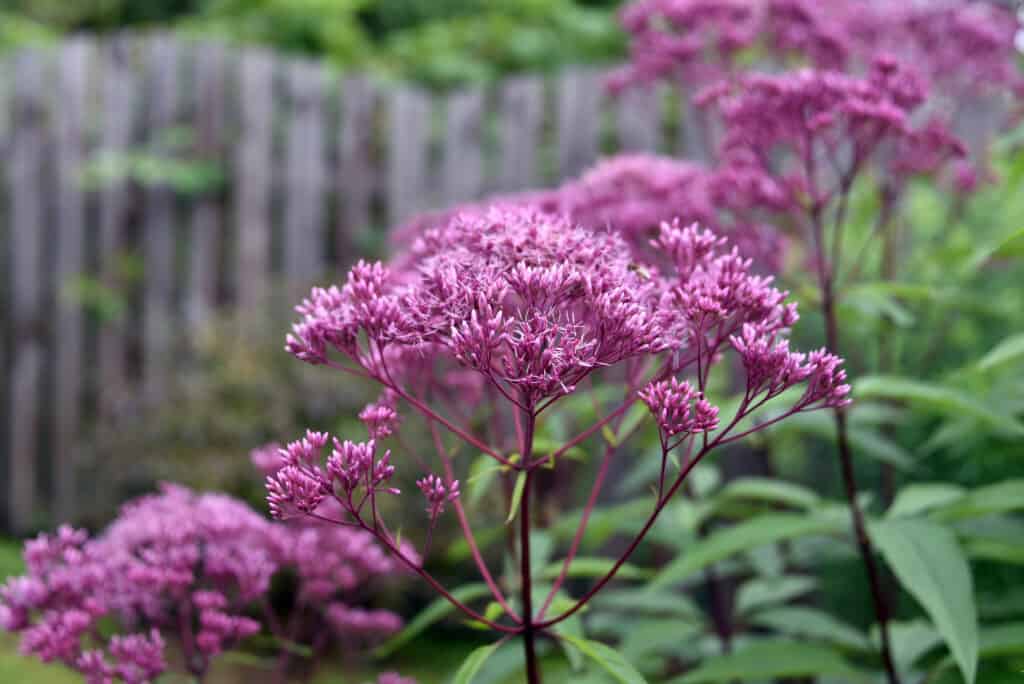
The common name for
Eupatorium Purpureumis Joe Pye Weed.
©Andrey_Nikitin/Shutterstock.com
Aromatic Aster (Symphyotrichum oblongifolium)
The scientific name of Aromatic Aster is Symphyotrichum oblongifolium. Its lavender-blue blossoms and delightful fragrance create a captivating landscape. Spring or fall is the optimal planting time, allowing the plant to establish its roots before its gorgeous autumn bloom from August to September. This perennial flourishes under the sun’s warmth, thriving in full sun. Its maintenance is slightly more than Joe Pye Weed or St. John’s Wort. Ensuring well-draining soil and moderate watering will yield the best results.

Aromatic Aster (
Aster oblongifolius) has bright lavender-blue daisy-like flowers.
©Olena Brodetska/Shutterstock.com
Cardinal Flower (Lobelia cardinalis)
Lobelia cardinalis, aptly named Cardinal Flower, is another herbaceous perennial on our list of the best flowers to plant in Missouri. It dazzles with its erect spikes of tubular flowers, a favorite among hummingbirds. Planting in spring is recommended, allowing its roots to settle before its vivid blooming in July to September. Basked in full sun to partial shade, the Cardinal Flower flourishes in moist conditions, often found near water bodies. Adequate watering is crucial, as it prefers medium to wet watering and consistently damp soil.

Cardinal Flower is a favorite among hummingbirds due to its color and tubular-shaped flowers.
©Tom Meaker/Shutterstock.com
Blue Star (Amsonia hubrichtii)
The scientific name of Blue Star is Amsonia hubrichtii. It has fine-textured foliage and starry blue flowers. This herbaceous perennial’s beauty shines best when planted in spring, permitting its roots to establish before it blooms from April to May. Thriving in full sun to partial shade, the Blue Star appreciates well-drained soil and moderate watering. Its low-maintenance nature makes it a charming addition to any garden.
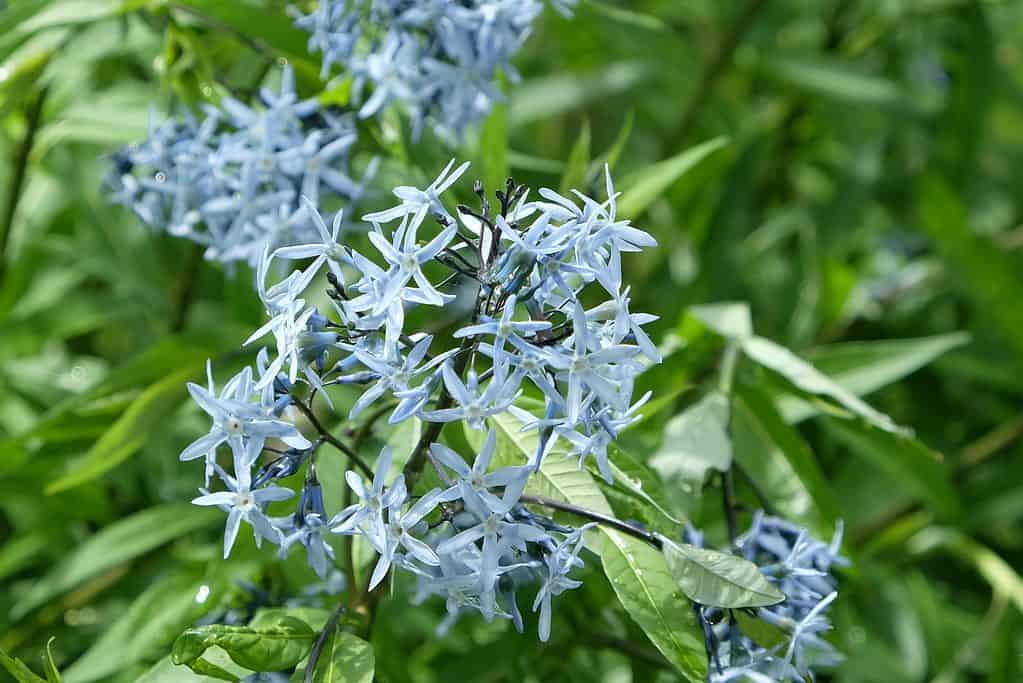
Blue Star thrives in full sun to partial shade.
©Alex Manders/Shutterstock.com
Butterfly Weed (Asclepias tuberosa)
Asclepias tuberosa, or Butterfly Weed, is a native herbaceous perennial with clusters of vibrant orange flowers that draw butterflies and pollinators. As a native flower, it is one of the best flowers on our list of the best flowers to plant in Missouri. Planting in spring is recommended, giving its extensive root system time to establish. It often blooms from June to August. Thriving in full sun, the Butterfly Weed is drought-tolerant once established, preferring well-drained soil. It prefers dry to moderate watering, allowing the soil to dry between watering sessions.
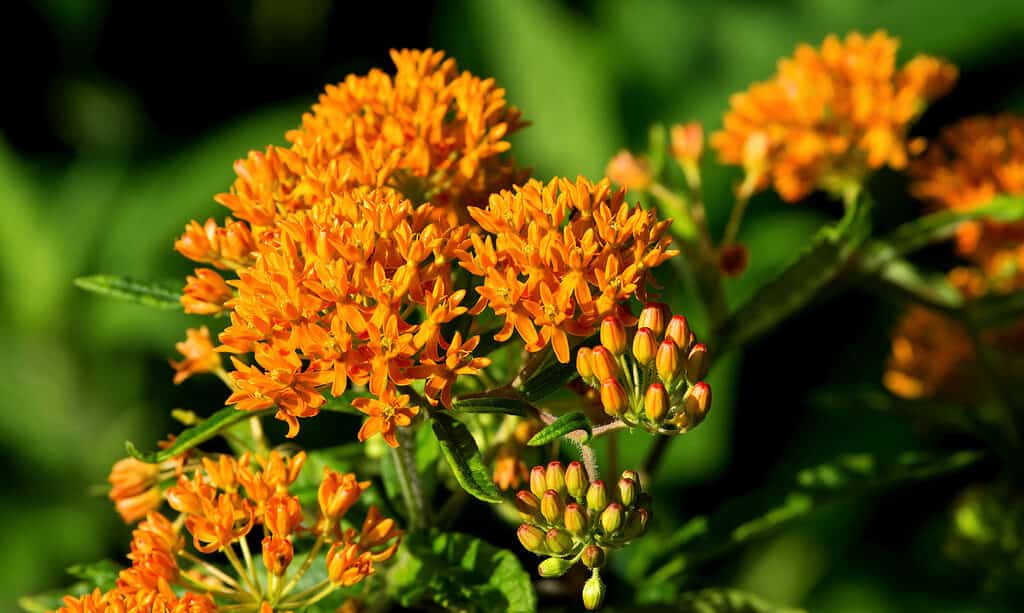
Butterfly Weed is appropriately named as it attracts butterflies and other pollinators.
©iStock.com/McKinneMike
Red Valerian (Centranthus ruber)
Red Valerian, or Centranthus ruber, is another flower on our list of the best flowers to plant in Missouri. This flower shows off clusters of pale red to crimson red flowers. It is a tough-as-nails herbaceous perennial and a breeze to plant, with spring as the prime time for introducing it to your landscape. Its blooming season is most prominent in May, typically lasting several weeks. Thriving in full sun to partial shade, the Red Valerian is tolerant of various soil types, making it a versatile choice for your garden. Its moderate water needs suit Missouri’s climate well, though it is tolerant of drought conditions.
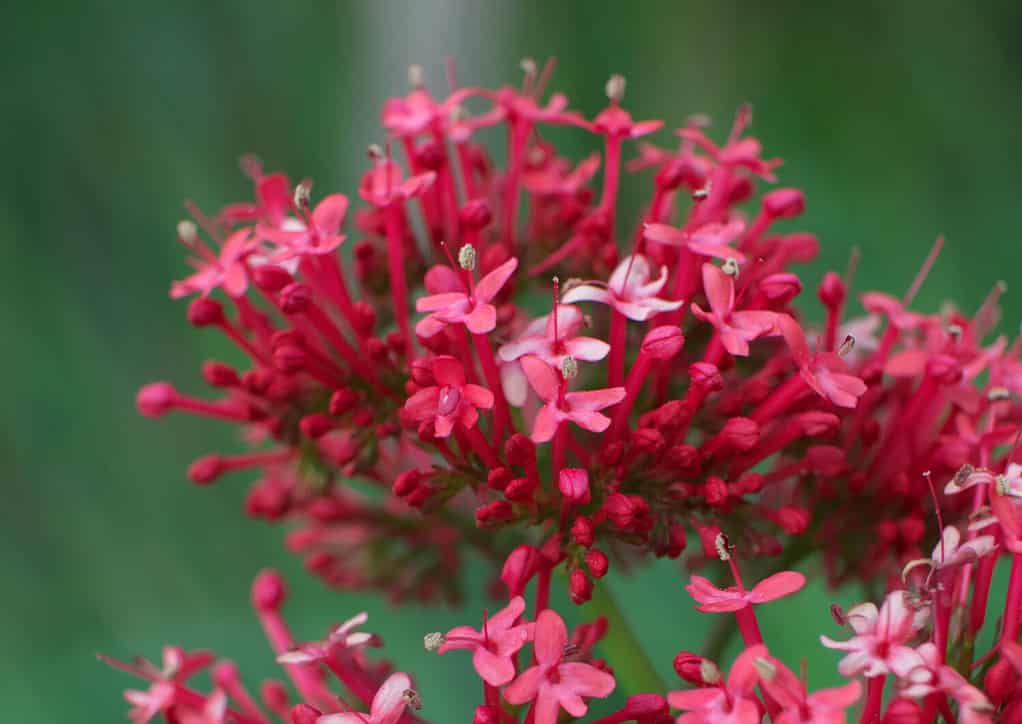
Red Valerian is a stunning flower with colors from pale red to crimson red.
©Stan Banash/Shutterstock.com
Siberian Bugloss (Brunnera macrophylla)
The scientific name of Siberian Bugloss is Brunnera macrophylla. It has heart-shaped leaves, resembling a painter’s canvas, and small, blue flowers with white centers. Spring is the perfect time to plant this herbaceous perennial, giving it ample time to establish its roots before it blooms with delicate blue flowers from April to May. Its bloom usually lasts for a month. In the sun-dappled spaces of Missouri, it prefers partial shade. When it comes to watering, keep the soil consistently moist with moderate water but not waterlogged, ensuring a comfortable environment for this stunning plant.
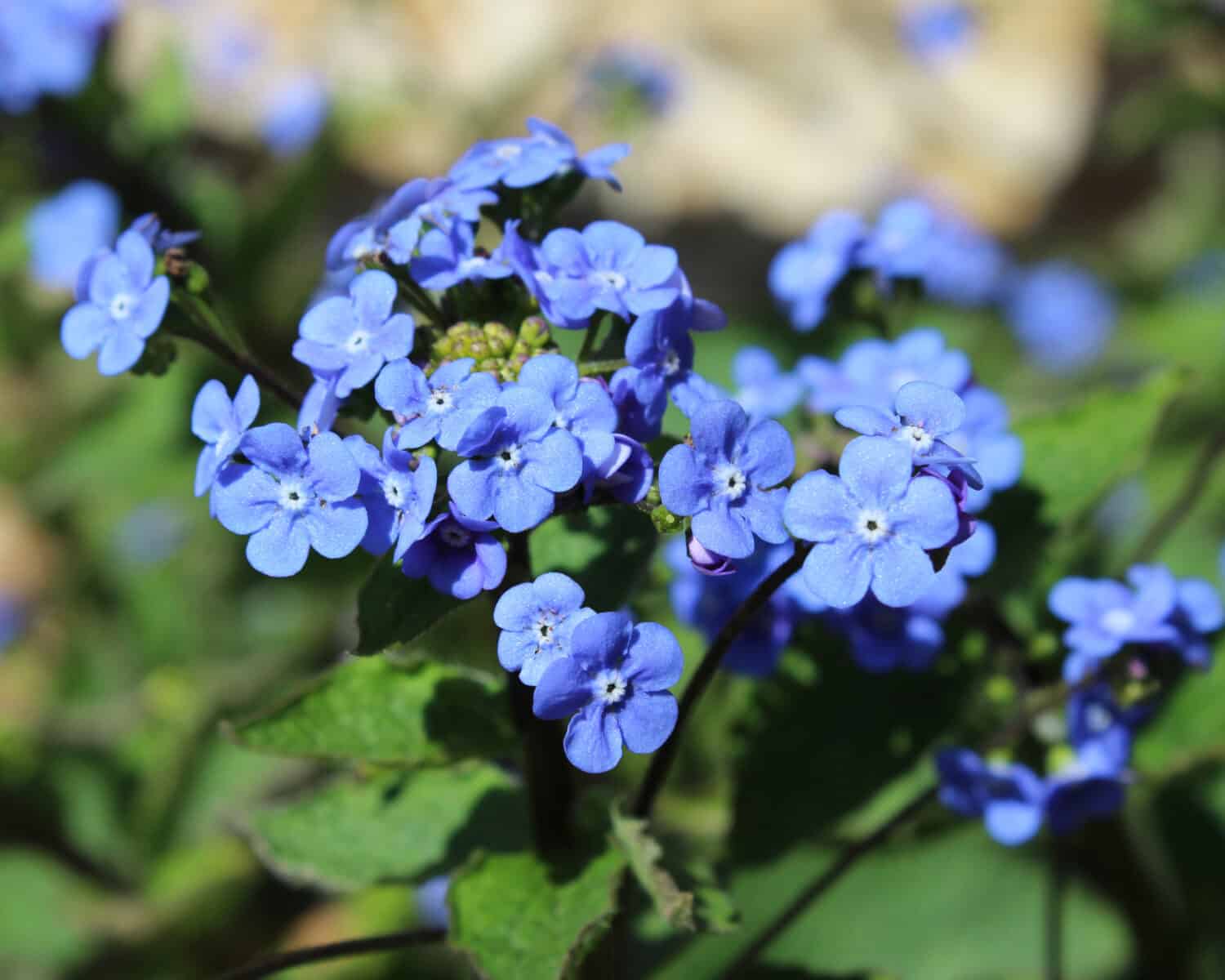
Siberian Bugloss, or
Brunnera macrophylla, produces dashing little blue flowers.
©Imladris/Shutterstock.com
Bleeding Heart (Dicentra spectabilis)
This classic beauty has a spot on our list of the best flowers to plant in Missouri for good reason. The scientific name of the Bleeding Heart is Dicentra spectabilis. Its unique white and pink flowers resemble dangling hearts. The blooming magic begins in spring, typically April to May, and continues for 4 to 6 weeks. Its flowers, with their distinctive shape and colors, create a mesmerizing visual spectacle. In the sun-dappled spots of Missouri, partial shade to full shade is where this flower thrives. Maintenance for this flower is low, and watering should be moderate, allowing the soil to remain consistently moist but not soggy.
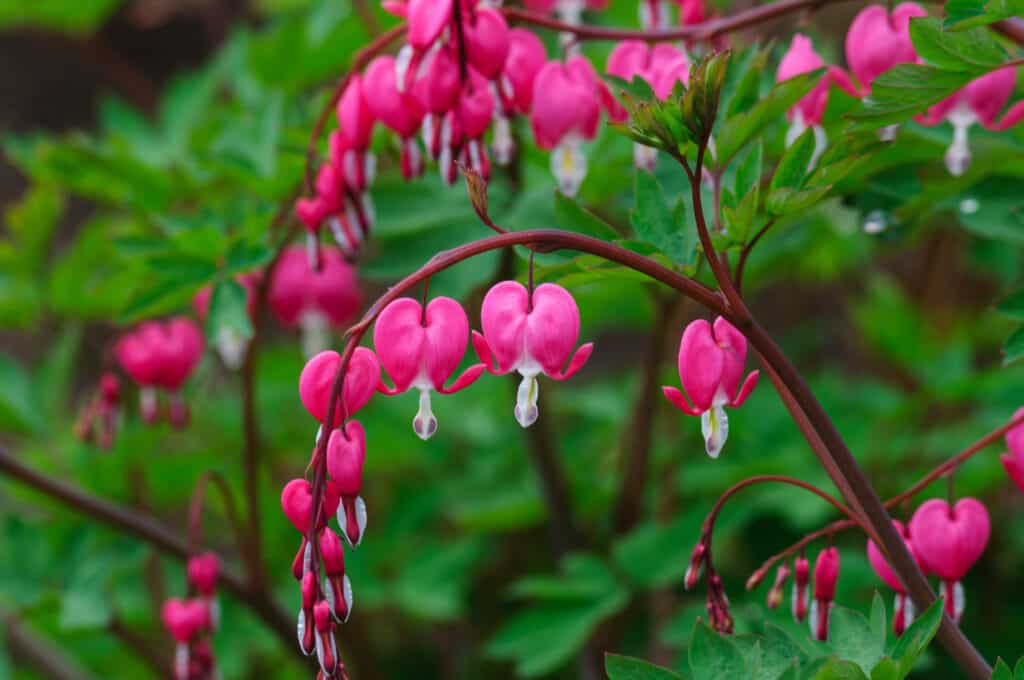
Bleeding Heart is a classic flower that blooms most prominently from April to May.
©Vahan Abrahamyan/Shutterstock.com
Pigsqueak (Bergenia cordifolia)
Pigsqueak, or Bergenia cordifolia, has robust foliage and charming, vibrant blooms. This flower made it on our list of the best flowers to plant in Missouri for more than just its silly name. It earns its quirky name from the sound its leaves make when rubbed together, which sounds similar to that of a pig. Spring is the time to introduce this tough beauty to your garden, allowing its roots to settle before its striking pink or magenta flowers emerge from April to May. These blooms typically last for about 3 to 4 weeks. Pigsqueak loves the embrace of partial shade to full shade in Missouri’s gardens. When it comes to watering, maintain consistently moist soil, providing this hardy gem the nurturing it craves.
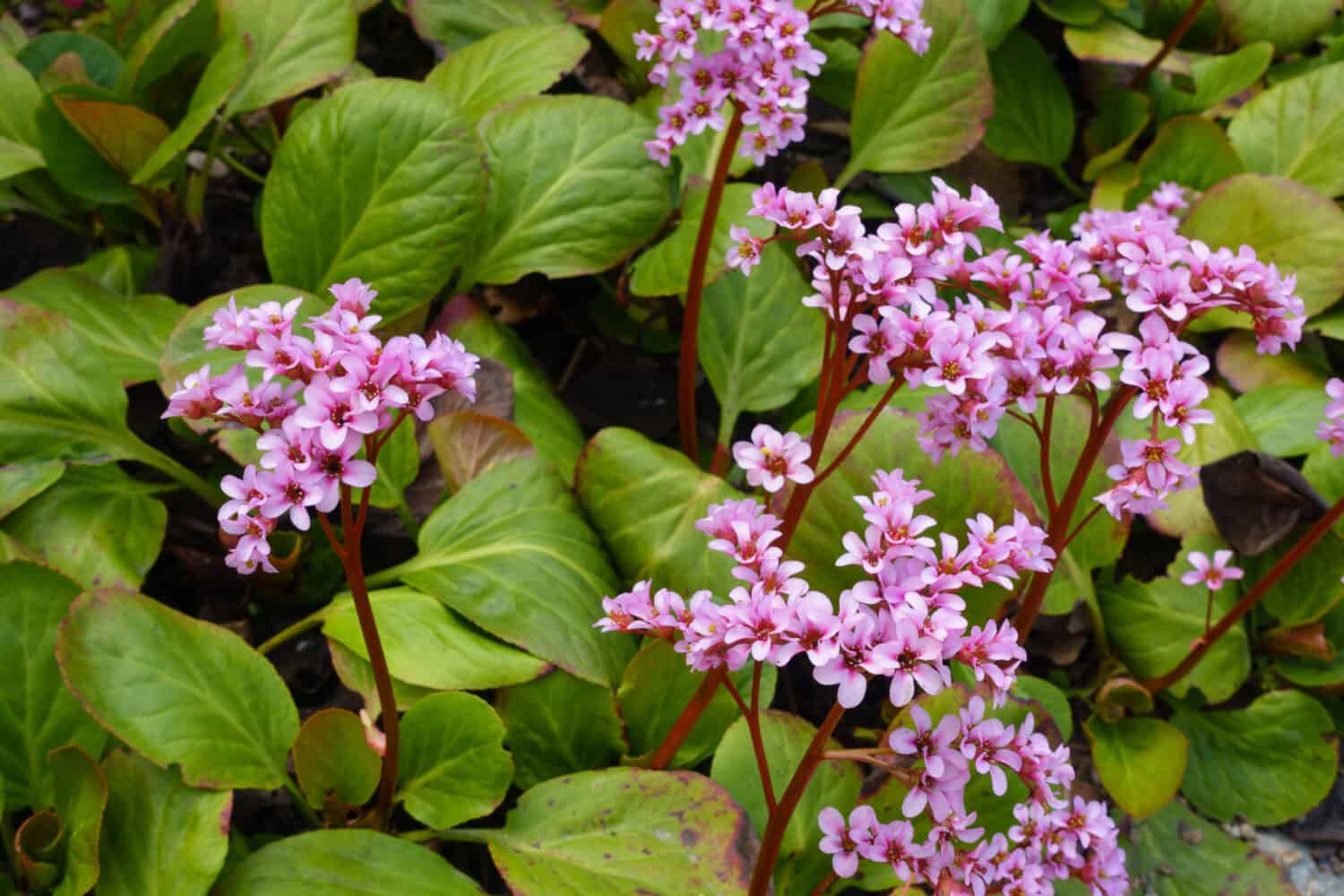
Pigsqueak, or
Bergenia cordifolia, got its quirky name from its rubbery leaves, that, when rubbed together, produce a sound similar to a pig.
©Elena Terletskaya/Shutterstock.com
Purple Coneflowers (Echinacea purpurea)
The scientific name of Purple Coneflowers is Echinacea purpurea. It stands as an iconic flower across the United States, including Missouri, solidifying its place on our list of the best flowers to plant in Missouri. These tough and enduring herbaceous perennials showcase their vibrant purple-to-pink petals, forming a distinctive cone-like shape. Spring or fall is ideal for planting, giving these beauties time to root. They tend to bloom from June to August. The blooming period lasts 8 to 12 weeks, inviting pollinators to feast on nectar. They prefer full sun to partial shade. While drought-tolerant once established, providing dry to moderate water ensures optimal growth and flowering, painting the garden in shades of purplish vitality.
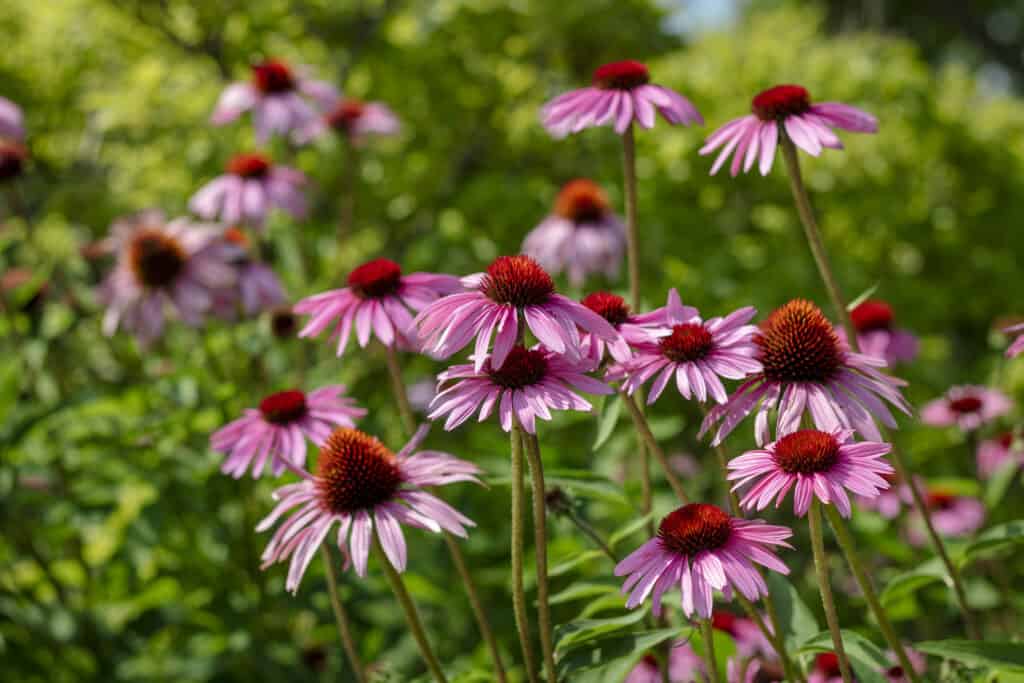
Purple Coneflowers are an iconic flower that can thrive in Missouri.
©iStock.com/Air Footy
Bear’s Breeches (Acanthus spinosus)
Bear’s Breeches, or Acanthus spinosus, commands attention with its architectural beauty and unique flowers. Its striking spiky blooms emerge in late spring to early summer, usually in June to August, for about 4 to 6 weeks. Its distinctive leaves lend an air of elegance around bold flower spikes ranging in colors from dull pink to mauve with accents of white. Bear’s Breeches thrive in partial shade to full sun, adapting to various conditions. When it comes to watering, keep the soil consistently moist with moderate watering.
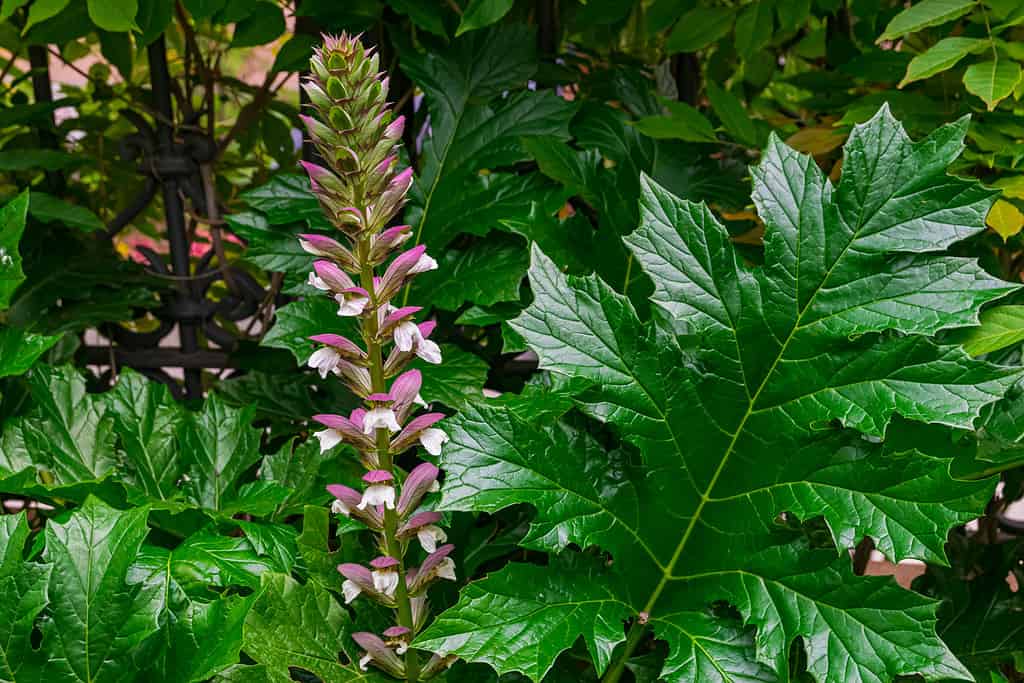
Bear’s Breeches, or
Acanthus spinosus, produces horizontal spires of spiky blooms that emerge in late spring to early summer.
©iStock.com/Martin Leber
Astilbe (Astilbe × Arendsii ‘Fanal’)
This is a unique hybrid on our list of the best flowers to plant in Missouri. The scientific name of Astilbe is Astilbe x Arendsii ‘Fanal.’ It is a group of hybrids. They include crosses between A. chinensis, A. japonica, A. thunbergii, and A. astilboides. Its feathery plumes of deep red blooms dance above its lush green foliage. Spring planting offers the best start, as it tends to bloom in July. Astilbe’s flowering period lasts for about 4 to 6 weeks. Maintenance requirements are low for this darling flower. In the dappled sunlight of Missouri, partial shade to full shade is its preference. Keep the soil consistently moist, as Astilbe thrives with moderate watering, reflecting its affinity for the water’s edge in its natural habitat.
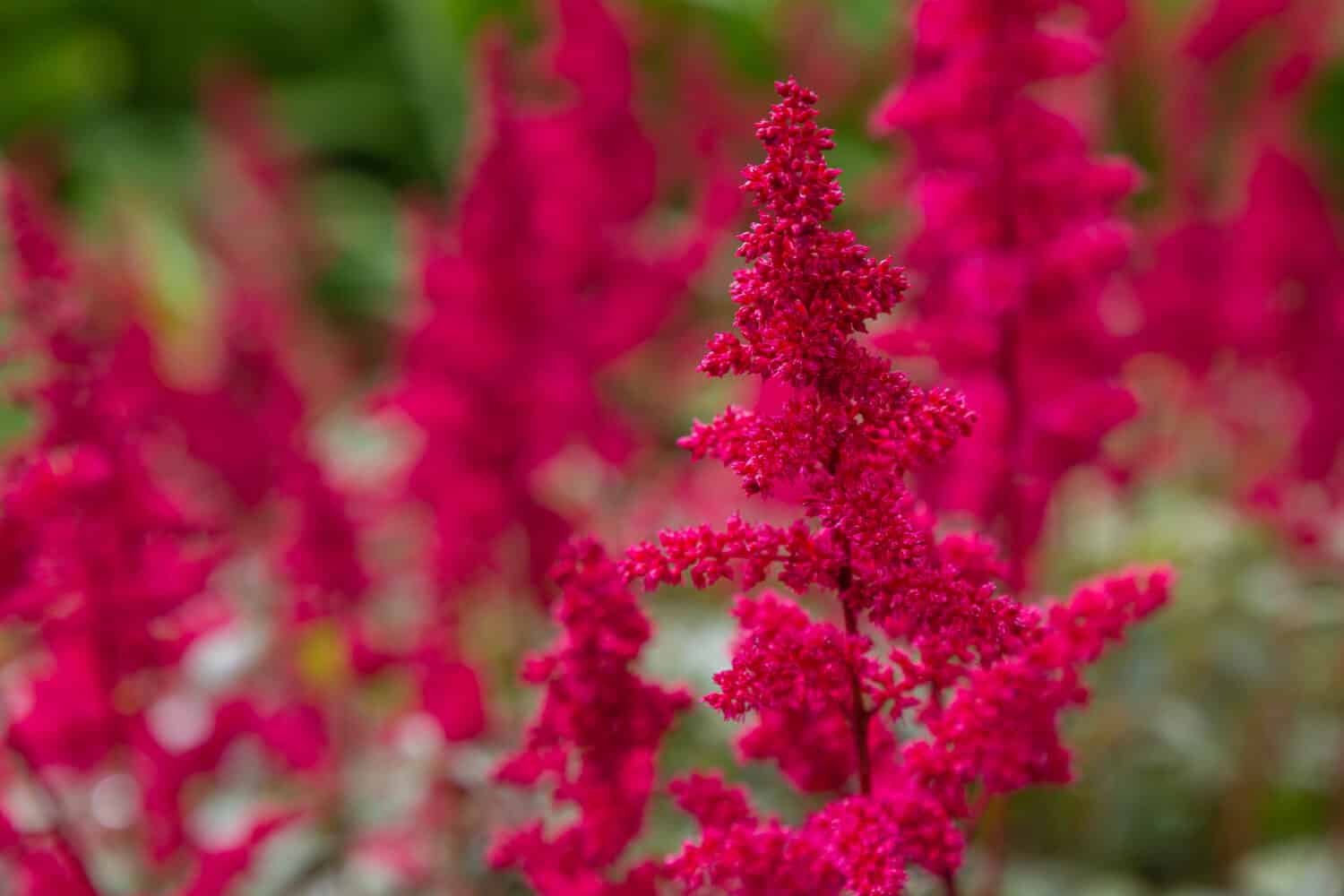
This unique hybrid of Astilbe,
Astilbex
Arendsii‘Fanal,’ includes crosses from include crosses between
A. chinensis, A. japonica, A. thunbergii, and
A. astilboides.
©Flower_Garden/Shutterstock.com
Virginia Bluebells (Mertensia virginica)
Virginia Bluebells, or Mertensia virginica, emerge as a true harbinger of spring in Missouri. These enchanting herbaceous perennials showcase pendulous clusters of pink buds that transform into captivating blue flowers. Their blooming period begins as one of the earliest in Missouri, starting in March and lasting through April. Their flowering period brings a burst of color to the garden. Virginia Bluebells flourish under partial shade to full shade in Missouri’s climate. When it comes to watering, maintain consistently moist soil with moderate watering, mirroring the riverbank habitats these native beauties adore.
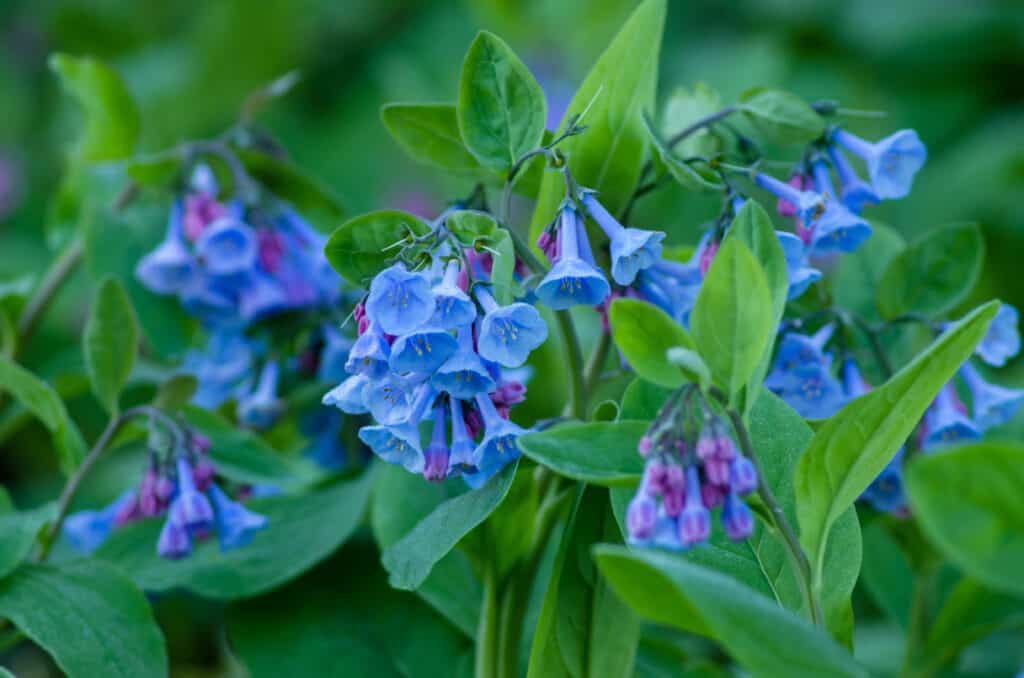
Virginia Bluebells usually have blue flowers that a bell-shaped.
©iStock.com/Joshua Moore
Bugleweed (Ajuga reptans ‘Catlin’s Giant’)
Bugleweed, Ajuga reptans ‘Catlin’s Giant,’ can carpet the ground with its vibrant foliage and spiky flowers. Its flowers are deep blue-violet, with large, shiny dark green leaves forming dense mats, creating a dramatic effect. Spring or fall planting is ideal. Its blue-violet blooms emerge and thrive from April to May. The flowering period typically lasts for 4 to 6 weeks. In Missouri’s sunlit spaces, full sun to partial shade is this beauty’s preference. Watering should be moderate, maintaining soil moisture without waterlogging.

Bugleweed has flowers that are deep blue-violet, with large, shiny dark green leaves forming dense mats.
©iStock.com/Albin Raj
Cranesbill (Geranium ‘Gerwat’ Rozanne)
Another flower on our list of the best flowers to plant in Missouri is Cranesbill or Geranium ‘Gerwat’ Rozanne. It enchants with its prolific blooms and elegant charm. This herbaceous perennial showcases violet-blue flowers with delicate white centers, creating a stunning contrast against its deeply cut foliage. It blooms from May to July in Missouri. Lighter blooms can continue throughout summer into fall, with a blooming period spanning a remarkable 5 to 6 months. Flourishing under the sun’s warmth, it prefers full sun to partial shade in Missouri. As for watering, maintain consistently moist soil to encourage optimal growth and flowering through moderate watering.

Cranesbill is a herbaceous perennial with violet-blue flowers that have delicate white centers.
©guentermanaus/Shutterstock.com
Columbine (Aquilegia Cardinal)
A popular flower on our list of the best flowers to plant in Missouri is Columbine. The scientific name for this Columbine is Aquilegia Cardinal. It has intricate and colorful blooms, a bicolor of red and white flowers, and various intricately shaped petals. Hummingbirds are particularly attracted to this plant. Spring planting offers the best start, allowing its roots to establish before its captivating optimal blooming period from April to May. Columbine thrives under full sun or partial shade in Missouri, embracing the dappled sunlight. Watering should be moderate, maintaining soil moisture without overwatering.
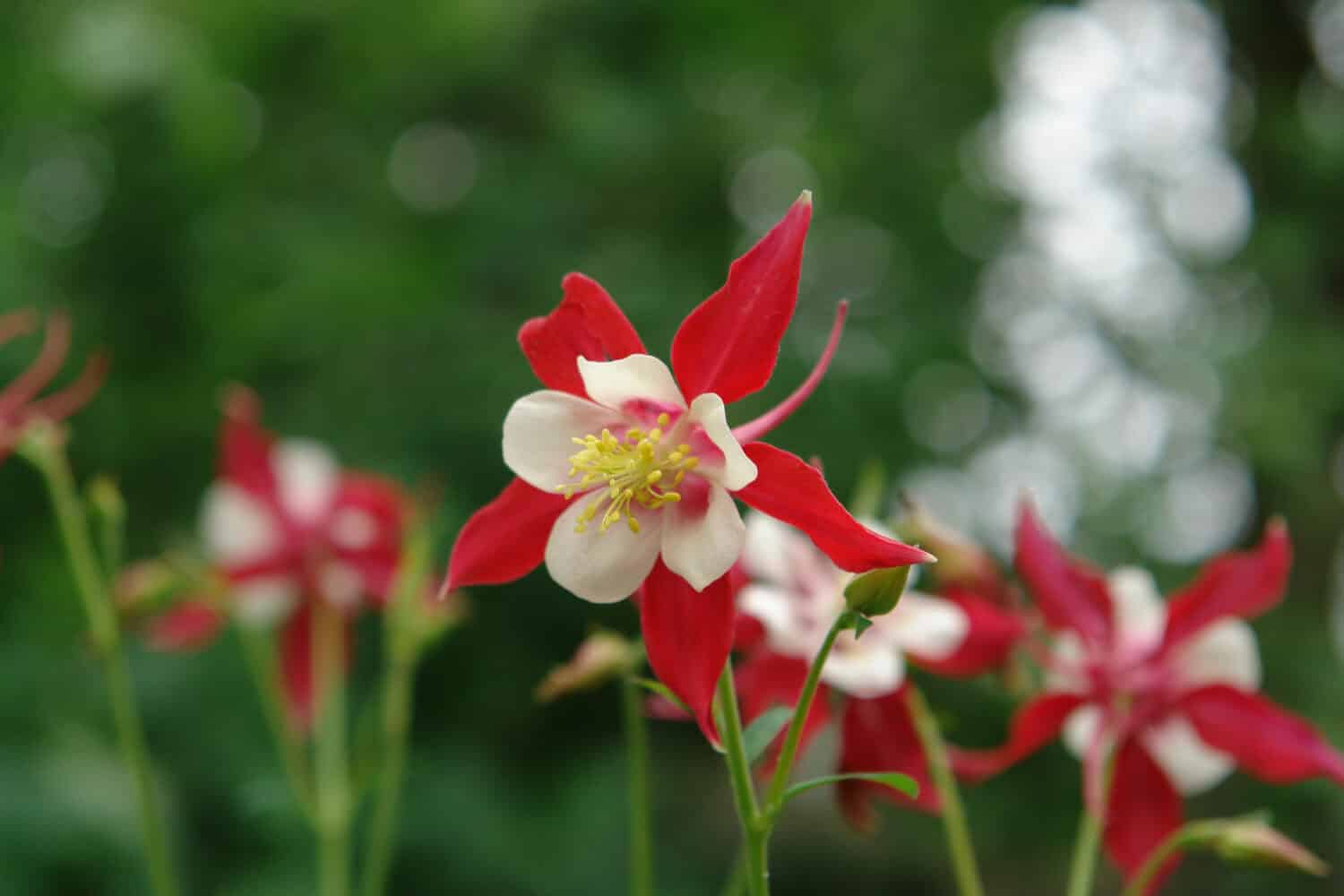
Cardinal is a type of Columbine that produces a bicolor of red and white. It is also referred to as Granny’s Bonnet.
©prambuwesas/Shutterstock.com
Lenten Rose (Helleborus orientalis)
The scientific name of the Lenten Rose is Helleborus orientalis. Its unique blooms showcase shades of pink, purple, or white, often blooming amid lingering winter snow. Its leaves are evergreen. Fall or early spring planting is recommended, giving it time to establish roots before its exquisite bloom is most abundant in April. The Lenten Rose adds elegance to shaded corners as it flourishes in partial shade to full shade. When it comes to watering, maintain consistently moist soil with moderate watering, ensuring this delicate beauty can thrive comfortably.

Lenten Rose isn’t a rose, it’s a herbaceous perennial from the buttercup family.
©iStock.com/nickkurzenko
Black-eyed Susans (Rudbeckia hirta)
Black-eyed Susans, Rudbeckia hirta, stand as another iconic Missouri native on our list of the best flowers to plant in Missouri. It illuminates the landscape with cheerful yellow blooms and dark brown centers. These tough perennials bloom the strongest from June to September, painting the garden with 3 to 4 months of continuous color. It prefers full sun, embracing Missouri’s abundant sunlight. Watering should be moderate, allowing the soil to dry between sessions. These resilient beauties reflect Missouri’s natural spirit, thriving with minimal care while attracting pollinators like butterflies and spreading visual joy throughout the seasons.
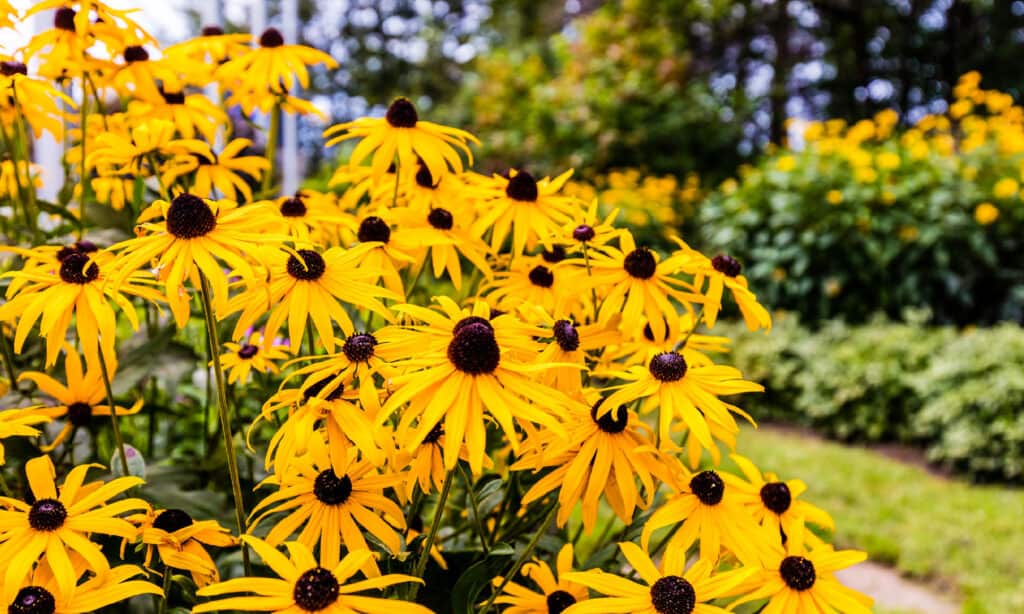
The Black-eyed Susan is a Missouri native with bright yellow petals and dark brown centers.
©iStock.com/Dopeyden
Ornamental Onion (Allium giganteum)
The ornamental onion, Allium giganteum, is a flowering plant that resembles something out of a Dr. Seuss book with its towering presence and spherical flower heads. This bulb showcases striking purple blooms that resemble fireworks frozen in time or simply fluffballs common in arts and crafts materials. Fall is the recommended planting time. This flower blooms dramatically in late spring to early summer, usually from May to June. It flourishes under the full sun. Moreover, the ornamental onion makes a statement in sunny Missouri gardens. As for watering, allow the soil to dry between sessions but utilize moderate water.

Ornamental Onion, or
Allium giganteum, has spherical flower heads that are purple. Its playful appearance resembles something from the world of Dr. Seuss.
©Zigmunds Dizgalvis/Shutterstock.com
Yarrow (Achillea millefolium)
Last on our list of the best flowers to plant in Missouri is Yarrow. The scientific name of this Yarrow is Achillea millefolium. It is a timeless beauty with intricate flower clusters. This tough species of Yarrow showcases primarily white flowers that resemble delicate lace. Planting in spring or fall is ideal. Its blooming period is typically from June to September. The flowering period spans 8 to 12 weeks. Yarrow thrives in Missouri’s sunny landscapes and prefers full sun. Watering should be dry to moderate, as this hardy beauty adapts well to various conditions, reflecting its resilience in the face of changing weather.

The flowers of Yarrow resemble delicate lacework.
©Starover Sibiriak/Shutterstock.com
Summary of the 21 Best Flowers to Plant in Missouri
| Number | Common Name | Scientific Name | Sun Exposure |
|---|---|---|---|
| 1 | St. John’s Wort | Hypericum calycinum | Full sun to partial shade |
| 2 | Joe Pye Weed | Eutrochium purpureum | Full sun to partial shade |
| 3 | Aromatic Aster | Symphyotrichum oblongifolium | Full sun |
| 4 | Cardinal Flower | Lobelia cardinalis | Full sun to partial shade |
| 5 | Blue Star | Amsonia hubrichtii | Full sun to partial shade |
| 6 | Butterfly Weed | Asclepias tuberosa | Full sun |
| 7 | Red Valerian | Centranthus ruber | Full sun to partial shade |
| 8 | Siberian bugloss | Brunnera macrophylla | Partial shade |
| 9 | Bleeding Heart | Dicentra spectabilis | Partial shade to full shade |
| 10 | Pigsqueak | Bergenia cordifolia | Partial shade to full shade |
| 11 | Purple Coneflowers | Echinacea purpurea | Full sun to partial shade |
| 12 | Bear’s Breeches | Acanthus spinosus | Partial shade to full sun |
| 13 | Astilbe | Astilbe x Arendsii ‘Fanal’ | Partial shade to full shade |
| 14 | Virginia Bluebells | Mertensia virginica | Partial shade to full shade |
| 15 | Bugleweed | Ajuga reptans ‘Catlin’s Giant’ | Full sun to partial shade |
| 16 | Cranesbill | Geranium ‘Gerwat’ Rozanne | Full sun to partial shade |
| 17 | Columbine | Aquilegia Cardinal | Full sun to partial shade |
| 18 | Lenten Rose | Helleborus orientalis | Partial shade to full shade |
| 19 | Black-eyed Susans | Rudbeckia hirta | Full sun |
| 20 | Ornamental Onion | Allium giganteum | Full sun |
| 21 | Yarrow | Achillea millefolium | Full sun |
Conclusion
Some of the best flowers to plant in Missouri thrive in harmony with the USDA Plant Hardiness Zones 5b through 7b. Guided by this climatic compass, gardeners curate nature’s canvas. St. John’s Wort and Black-eyed Susans bring sunlit joy, while the Cardinal Flower enchants hummingbirds. Lenten Rose defies winter, Aromatic Aster scents the air, and Butterfly Weed dances with butterflies. Each flower is one of resilience and adaptation within Missouri’s diverse climates.
The photo featured at the top of this post is © VH-studio/Shutterstock.com
Thank you for reading! Have some feedback for us? Contact the AZ Animals editorial team.







